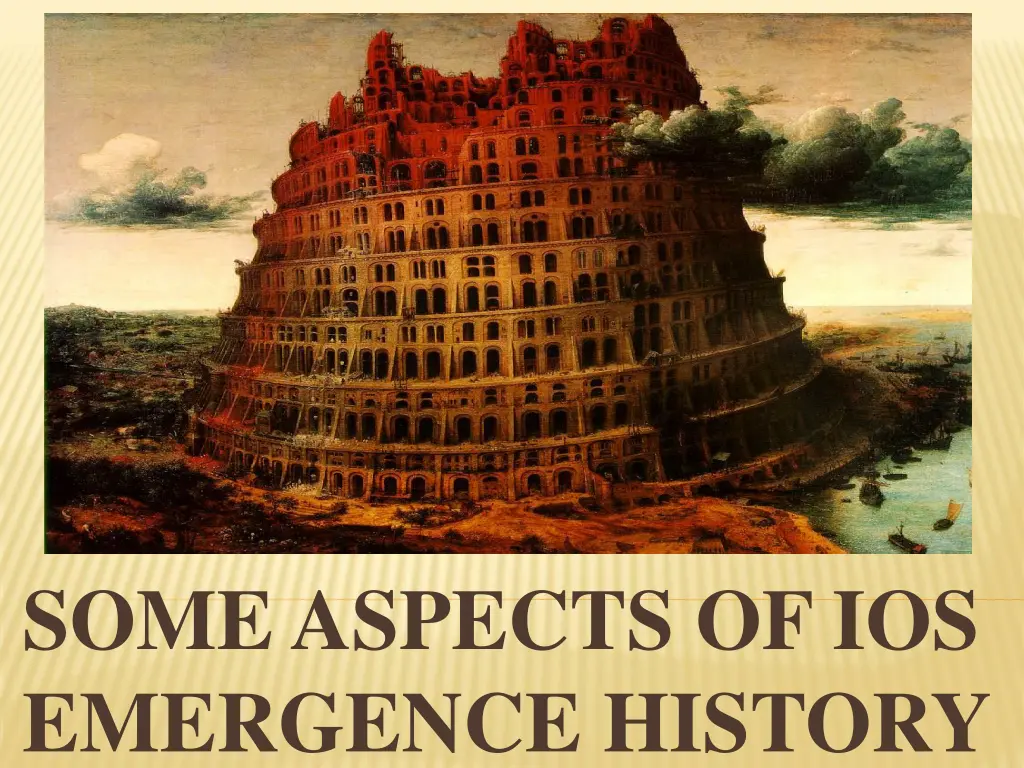
Aspects of Emergence History
Explore the historical aspects of IOs emergence from antiquity to the Middle Ages, including the formation of international associations like the Delian League and Hansa. Discover key drivers and features shaping international relations over time.
Download Presentation

Please find below an Image/Link to download the presentation.
The content on the website is provided AS IS for your information and personal use only. It may not be sold, licensed, or shared on other websites without obtaining consent from the author. If you encounter any issues during the download, it is possible that the publisher has removed the file from their server.
You are allowed to download the files provided on this website for personal or commercial use, subject to the condition that they are used lawfully. All files are the property of their respective owners.
The content on the website is provided AS IS for your information and personal use only. It may not be sold, licensed, or shared on other websites without obtaining consent from the author.
E N D
Presentation Transcript
SOME ASPECTS OF IOS EMERGENCE HISTORY
QUESTIONS 1. Antiquity 2. Middle Ages 3. Modernity 4. Contemporaneity
ANTIQUITY The most important prerequisite for international integration the emergence of states (IV-III millennia BC).
ANTIQUITY The emergence of the first IOs (mostly military) was caused by the following: 1) The complication of the forms of international communication; 2) The development of bilateral relations and trade.
ANTIQUITY One of the first international associations of this kind was the Delian League (478-404 and 378-337 BC, 208 member states); its tasks included: 1) Joint defense of the ancient Greek city-states (polis) from external enemies; 2) Resolving conflicts between the city-states; 3) Creating favorable conditions for economic expansion of the League members.
ANTIQUITY Delian League possessed: 1) Common military force; 2) Budget (treasury was in the sanctuary of Apollo on the isle of Delos, later in Athens); 3) Judicial system.
ANTIQUITY The most important problems related to the League were solved at general meeting which also elected the union leadership (Council of Elders, Ellinotamies). All the members of the union had an equal right to vote on the issues of its operation.
MIDDLE AGES Further complicating of international relations took place in the Middle Ages and in modern times. In the 13thcentury, Hansa emerged, which was a German trade association of independent city- states, whose tasks included: 1) Development of trade in the basins of the North and Baltic seas; 2) Protection of member cities rights against the attacks of feudal aristocracy; 3) Fighting piracy.
MIDDLE AGES Hansa possessed: 1) Common legislation; 2) Treasury; 3) Sales offices and warehouses in different parts of Europe (Bergen, Bruges, London, and Novgorod); 4) The navy (the association waged wars against other states).
MIDDLE AGES At various times, Hansa included as many as about 200 members. The most important issues of the association were decided at the annual convention (Hansetag) in its center, the city of Luebeck. The activity of Hansa lasted until the early 17thcentury.
MODERNITY Scholars distinguish four periods of modern IOs evolution: 1) The 19thcentury (the first IOs of modern type emerged); 2) Period between the two world wars (attempts were made to organize an international political cooperation on a global scale: the League of Nations, ILO, WHO); 3) First decades after the end of World War II (UN); 4) Since the beginning of the 1960s (massive emergence of new states instead of the former colonial empires took place alongside with the establishment of new IOs).
MODERNITY An international association with many features of modern IGOs was the Holy Alliance (established in 1815) whose tasks were: 1) Protection of the principle of legitimacy; 2) Fighting revolutionary movement.
MODERNITY In the course of time all the monarchical states of continental Europe joined the Holy Alliance . Critical issues related to the functioning of this association were resolved at its congresses in Aachen (1818), Troppau (1820), Laibach (1821), and Verona (1822).
MODERNITY In 1818, the development of international trade in Europe led to the formation of the Commission for Navigation on the Rhine River, an international organization whose objectives were: 1) Regulation of trade and tariffs on the Rhine, one of major navigable rivers of Europe; 2) Establishing rules and regulations to ensure freedom of navigation on the Rhine common for all members of the Commission; 3) Settlement of disputes between member states.
MODERNITY In 1821, a commission similar to that for Navigation on the Rhine River was set up to regulate trade and navigation on the Elba River, and in 1856 on the Danube.
MODERNITY In many ways revealing is the history of the emergence of the International Telegraph Union at the international conference in Paris in 1865 with the participation of twenty nations. This was preceded by the establishment of the Telegraph Union in 1850, which included the German-speaking nations of Europe and the Netherlands.
MODERNITY In 1855, emerged the Telegraphic Union of Western Europe including Belgium, France, Portugal, Spain, and Switzerland. Finally, the rapid development of communications revealed the need to organize a broader association which occurred at the Paris conference.
MODERNITY Another organization fully complying with modern concepts of IGOs became the Universal Postal Union (UPU) whose establishment was initiated at the conference in Paris in 1863 on the initiative of the US Post Office.
MODERNITY The UPU finally took shape in 1874 and besides the European countries it included the U.S. and Egypt. The union bears its current name since 1878 and from 1948 it is one of the UN specialized agencies.
CONTEMPORANEITY One of the key points in the IOs system evolution was the creation of the League of Nations (1919) stipulated by the Treaty of Versailles; its objectives were following: 1) Development of the new rules of conduct in the international arena in order to prevent global conflicts similar to World War I; 2) Establishing a mechanism of collective security.
CONTEMPORANEITY The governing bodies of the League of Nations were the Assembly and the Council which consisted of four permanent members (Britain, France, Italy, and Japan) and four non-permanent ones, elected every three years.
CONTEMPORANEITY The structure of the League of Nations also included the Permanent Court of International Justice designed to resolve disputes and conflicts between its members on the basis of international law. At various times, 63 states were members of the League.
CONTEMPORANEITY In a relatively stable international environment of the 1920s the League of Nations successfully dealt with such international issues, as: 1) Territorial disputes between Sweden and Finland because of the Aland Islands; 2) Disputes between Turkey and Iraq because of Mosul; 3) Promotion of international economic relations; 4) Protection of minority rights; 5) Refugee assistance, etc.
CONTEMPORANEITY In 1919, the International Labor Organization (ILO) was added to the structure of the League of Nations which in the interwar period played a significant role in (a) protecting workers rights and (b) the improvement of the working legislation in a number of countries.
CONTEMPORANEITY The following measures may be credited to the ILO: 1) An introduction of the 8-hour working day in some countries; 2) The adoption of measures to curb child labor; 3) Protection of the rights of women workers. This organization joined the UN system in 1946 and exists to this day.
CONTEMPORANEITY The most important decisions of the League of Nations were based on the principle of unanimity which greatly reduced the effectiveness of the organization and ultimately led to the outbreak of World War II. For example, in 1931, when Japan attacked China and annexed Manchuria, the League refused to intervene without the participation of the U.S., thus leaving this violation of international law unpunished.
CONTEMPORANEITY After Adolf Hitler came to power in Germany (1933), Berlin committed itself to the revision of the Versailles-Washington system of international relations and left the League of Nations. Nothing was done to oppose the Italian aggression against Ethiopia in 1935 because of concerns about the possibility of the German-Italian deal.
CONTEMPORANEITY After the expulsion of the USSR from the League of Nations in 1939, the organization finally lost control of major international conflicts. Thus, the prestige of the League was undermined and it was finally dissolved in April 1946, its assets and liabilities transferred to the UN.
CONTEMPORANEITY The historical significance of the League of Nations: 1) It was the first global IGO which for the first time in history dealt with such a wide range of international problems; 2) Experience of the League, however mostly negative, laid the basis of the system of international relations in the postwar period.





















